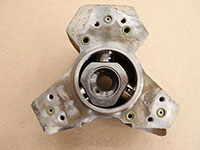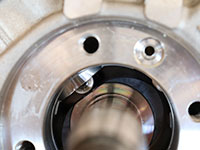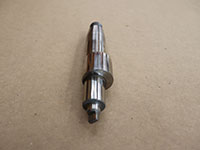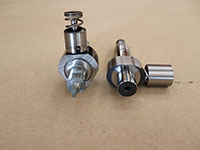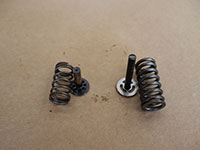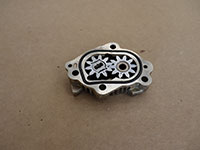Our first glimpse of the Bosch CP4.2 injection pump came from the 4.5L Duramax prototype unveiled by GM in 2008. The engine, which never made it to the production stage, clearly sported a Bosch CP4 mounted through the front cover on the driver side. For 2011, the CP4 became standard equipment on 6.6L Duramax and 6.7L Power Stroke turbodiesels, and the applications list has grown substantially since then with many modern engines employing this pump design. While it is regarded as a highly efficient injection pump, it's come under fire in recent years due to widespread reliability concerns and the often catastrophic ways in which it fails. Is the CP4 a ticking time bomb? How can failures be prevented? What causes they CP4 to fail in the first place? In this article we'll dive deep into the Bosch CP4 and examine how it works, why it fails, and what you can do to prevent becoming a victim of a CP4 pump failure.
Bosch CP4 Injection Pump Overview
The Bosch CP4.2 injection pump is the heart of the high pressure common rail system found in a wide range of diesel engines across the world. In many domestic applications it was employed as a high efficiency replacement for the long-running model CP3.3 injection pump (found in 2001 - 2010 Duramax diesels, 2003 - 2018 Cummins turbodiesels, for example).
The case of the CP4 is cast from lightweight aluminum and is flooded with diesel fuel to provide lubrication for the various rotating and reciprocating assemblies. Internally, the injection pump is quite simple and relies on a rotating camshaft which actuates roller followers (lifters) attached to plunger assemblies that pressurize fuel that is then delivered to the high pressure fuel rail(s). This injection pump is timed so that fuel pressure pulses correspond with injection events, maintaining the pressure commanded by the engine control module as the injectors discharge.
CP4 injection pumps quickly became the source of total fuel system failures and have become widely unpopular amongst diesel owners due to their questionable reliability and tendency to contaminate the entire fuel system when a failure event occurs. Many believe that the CP4 is nothing more than a ticking time bomb, as evidenced by its reportedly high failure rate. As a result, it is the source of many ongoing class action lawsuits in the United States, none of which have produced any action or results at the time of publishing.
Applications Employing the Bosch CP4.2
The Bosch CP4 injection pump is found in the following domestic applications, in addition to a variety of application examples globally:
2011 - present Ford Super Duty (6.7L Power Stroke V-8)
2011 - 2016 GMC Sierra 2500HD, 3500HD (6.6L Duramax LML V-8)
2011 - 2016 Chevrolet Silverado 2500HD, 3500HD (6.6L Duramax LML V-8)
2011 - 2016 GMC Savana 2500, 3500 (6.6L Duramax LGH V-8)
2011 - 2016 Chevrolet Express 2500, 3500 (6.6L Duramax LGH V-8)
2019 - 2020 Ram Trucks Ram 2500, 3500, 4500, 5500 (6.7L Cummins I-6)
2014 - present Ram Trucks Ram 1500 (3.0L EcoDiesel V-6)
2014 - 2019 Jeep Grand Cherokee (3.0L EcoDiesel V-6)
2018 - 2021 Ford F-150 (3.0L Power Stroke V-8)
Notable is the fact that Cummins employed the CP4 for two model years before returning to the previous generation Bosch CP3 injection pump for 2021 model year engines. It would seem that even their brief stint with the CP4 produced large enough concern (and outspoken protests) to send engineers scrambling to save the Cummins namesake. Ford Motor Company has employed the CP4 longer than any competing manufacturer as all 6.7L Power Stroke diesels possess this injection pump.
The 6.6L Duramax LML fuel system is unique in that it does not utilize an electric low pressure lift pump to keep the CP4 supplied with fuel, relying instead on a positive displacement gear-type pump similar to that found mounted at the rear of the CP3. Cummins and Power Stroke applications both employ an electric lift pump, which cycles "on" when the key is turned to the "run" position. Although we can't say for certain that Duramax CP4 failures largely outnumber those reported on Power Stroke diesels, the Power Stroke's fuel system is widely more desirable and addresses fuel starvation concerns that may be a contributing factor to failures.
Basic Operation of the Bosch CP4.2
Fuel is either drawn or pumped into the injection pump where its flow is split between two circuits. The first circuit feeds the fuel plungers while the second circuit floods the crankcase, providing lubrication to the internal reciprocating and rotating assemblies. Fuel flow to the plunger chambers is metered by an electronic actuator, which will command more fuel when there is a high demand (i.e. high engine load) and less fuel when the demand is lower (i.e. idling, cruising at constant speed). The catalog name for the actuator can vary by manufacturer, but is is typically referred to as the fuel volume control valve (VCV, FVCV), fuel pressure regulator (FPR), or fuel control actuator (FCA). Some common rail systems also feature a relief valve to precisely control fuel rail pressure and bleed off excess through the return system.
A dual lobe camshaft with mirrored cam lobes positioned 180 degrees apart is driven by the engine via timing gear or belt. The cam lobes actuate two roller followers (roller lifters) each affixed to a fuel plunger assembly. When a follower begins ramping upwards on a cam lobe, the plunger begins its pressure stage. When a follower begins ramping down on a cam lobe, the plunger begins its vacuum stage.
Check valves (delivery valves) in the pressure chambers ensure that fuel flow is directionally regulated such that high pressure fuel exits the pump into the rail without return flow to the plungers. The CP4 is timed such that a pressure phase occurs at approximately the same time as an injection event (note that injection timing varies with operating conditions, but the injection pump timing is static). Each fuel plunger is actuated twice per revolution of the engine crankshaft, thus it is rotating at twice the speed of the engine.
Inside the Bosch CP4.2 Injection Pump
Note the following images are based on a Bosch CP4 injection pump pulled from a 6.7L Power Stroke diesel. While the operational principles and internal components are shared across vehicle makes and models, there are some slight differences, including the timing gear, between applications.
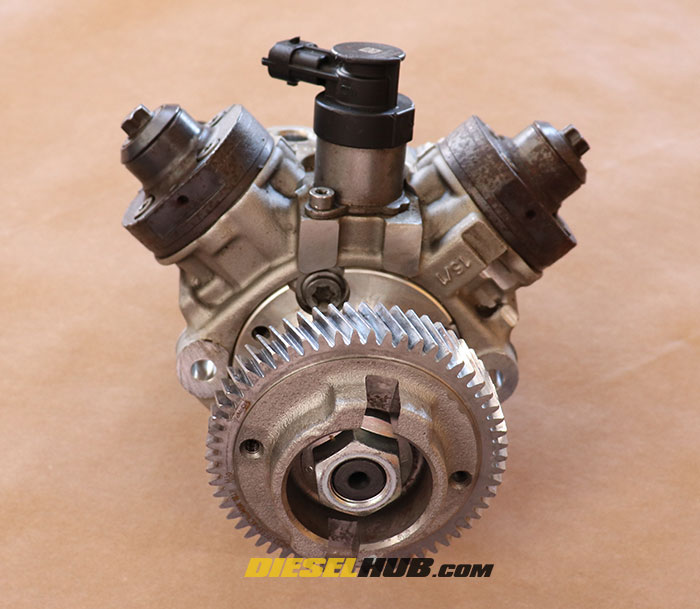
Bosch CP4.2 injection pump removed from a 6.7L Power Stroke
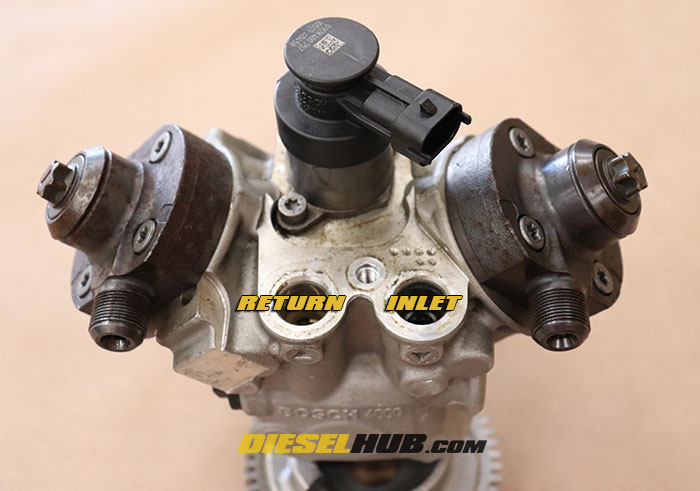
Bosch CP4.2 fuel inlet and outlet locations
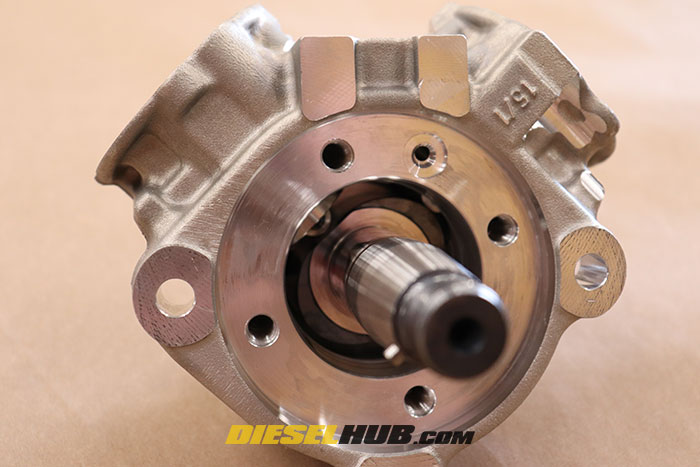
Bosch CP4.2 camshaft and roller follower close-up (crankcase cover removed)

Bosch CP4.2 roller follower (lifter) orientation from inside the crankcase

Bosch CP4.2 camshaft close-up
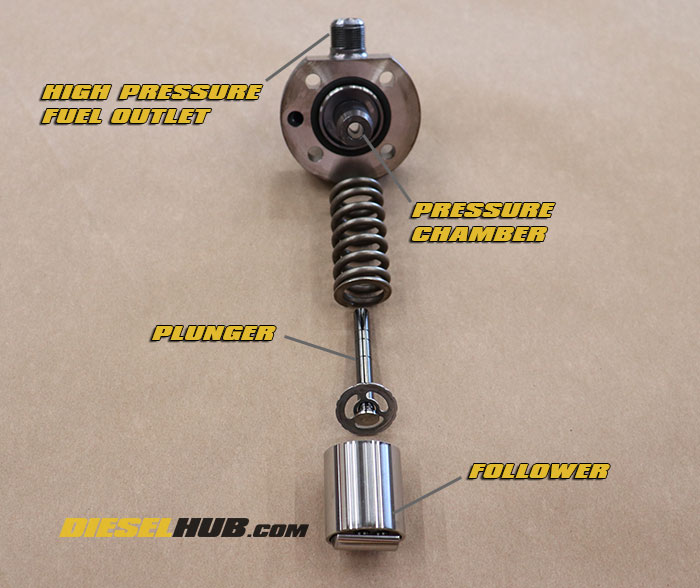
Bosch CP4.2 fuel plunger components laid out
Bosch CP3 vs CP4 Injection Pumps
Description |
Bosch CP3 |
Bosch CP4 |
|
Unit weight [1]: |
16 lbs 7 oz |
10 lbs 4 oz |
|
Case material: |
Steel alloy |
Aluminum alloy |
|
Camshaft type: |
Eccentric w/ polygonal translating ring |
Elliptical, dual lobe [2] |
|
Max advertised fuel pressure: |
26,000 psi |
36,000 psi [3] |
|
Fuel metering control: |
Electronic actuator |
Electronic actuator |
|
Low pressure pump type: |
Positive displacement |
Duramax applications |
Positive displacement |
Power Stroke applications |
Electric lift pump |
||
Cummins applications |
|||
Lubrication type: |
Flooded housing (diesel fuel) |
Flooded housing (diesel fuel) |
|
Gear fitment: |
Pressed fit (tapered shaft) |
Pressed fit w/ keyway (tapered shaft) |
|
Lifter/follower type: |
Bucket |
Roller |
|
# of fuel plungers: |
3 @ 120 degree separation angles |
2 @ 90 degree separation angle |
|
Fuel plunger diameter: |
0.295 in (7.5 mm) |
0.255 in (6.5 mm) |
|
Stroke length: |
0.322 in (8.2 mm) |
0.413 in (10.5 mm) |
|
Lifter diameter: |
1.014 in (25.95 mm) |
1.100 in (27.95 mm) |
|
[1] - Weight measured with gear and fuel control actuator.
[2] - Early versions of the CP4 feature an asymmetrical camshaft lobe design while later (phased in during 2020) feature a symmetric camshaft lobe profile.
[3] - Bosch advertises fuel pressure as high as 2,700 bar or 39,000 psi; Ford, GM, and Ram advertise max fuel pressure of 36,000 psi in CP4 applications.
Internal Differences Between CP3 & CP4 Injection Pumps
Click image to view fullsize in pop-up display
The Bosch CP3 features three pumping chambers and bucket type followers that ride on a polygonal ring. The polygonal ring causes the followers to move vertically in their bores by means of an eccentric (off-centered lobe) camshaft. While there is no mechanism in play to keep the buckets from rotating in their bore, slight rotational movements are unlikely to contribute to abnormal wear due to the nature of the contact and movement types.
The Bosch CP4 features two pumping chambers and roller type followers that ride on an elliptical dual lobe camshaft. Note that there is no mechanism in play to keep the roller followers from rotating in their bore, and any rotational movement with respect to the camshaft lobe position is likely to result in premature wear at the contact surfaces since the movement of the roller will be impeded under such circumstances.
The Bosch CP3 employs an eccentric type camshaft, meaning the centerline of the cam lobe and the centerline of the shaft do not intersect.
Bosch CP3 vs Bosch CP4 camshaft and follower orientations. While the movement of the cam lobe on the CP4 is rather aggressive, the CP3's is ultimately smooth with subtle engagements as a result of the polygonal ring, which does not rotate. While lubrication between the machined surfaces of the cam lobe and inner bore of the polygonal ring is critical, it is much more resilient to brief exposure to water contamination or pockets of air than the roller follower system employed by the CP4. The polygonal ring on the CP3 is also coated to reduce friction at the contact point with the followers, whereas the cam lobe on the CP4 is not.
The CP4 fuel plungers are significantly longer and larger in diameter than those found on the CP3. Additionally, a much stiffer spring is used on the CP4 to keep pressure between the follower and the camshaft.
The Bosch CP3 employs a positive displacement low pressure pump mounted at the rear of the injection pump housing. The Bosch CP4 in Duramax diesels features an identical low pressure pump at the rear of the housing, however the Power Stroke and Cummins versions of the pump do not; they rely on an electric lift pump to provide fuel to the CP4.
Bosch CP4 Injection Pump Failures
Failure rates of Bosch CP4 injection pumps are high enough that it has spawned multiple class-action lawsuits against automakers who've employed the device that seeks compensation for affected vehicle owners. The greatest concern is not that the injection pumps fail; any fuel pump has a finite life and will eventually require replacement. The problem lies in how the CP4 fails and the contamination it creates within the fuel system.
Typical CP4 Failure Event
The dreaded "failure event", as it has been coined, occurs when fine metal particles accumulate in the crankcase of the CP4. This is typically the result of wear between the roller follower and camshaft and/or the follower body and the cylinder wall. Most tear-downs of a CP4 after failing reveal particle buildup on the roller bearing of the follower and score marks on the camshaft lobe. Scuffing on the body of the follower is generally less severe and may be the result of metal particles being suspended in the lubricating fuel supply. The mesh screen on the fuel volume control actuator cannot secure the extremely fine metal particles created inside the crankcase and they eventually find their way into the pumping chambers where they are sent to the high pressure fuel rail(s). This litters the entire fuel system, from the fuel injectors to the fuel tank, with these metallic particles. Eventually, this debris prohibits proper operation of the fuel injectors, fuel volume control valve, and injection pump; the fuel system is effectively starved and the engine will begin to sputter before ultimately stalling and failing to restart.
The best case scenario following a CP4 failure is that the injection pump will need to be replaced. The worst case scenario, and seemingly more common occurrence, is that you'll need to replace the entire fuel system (injectors, common rail(s), injector lines, injection pump, lift pump, fuel filters, etc) and thoroughly clean the fuel tank. Most dealerships will warranty a failed CP4 pump, but not the entire fuel system should it require attention. Their argument, generally, is that the warranty does not cover fuel contamination, and once metal filings are distributed throughout the fuel system it is classified as a contamination issue that is not covered under the powertrain warranty (thus the pending class-action lawsuits). General Motors TSB 16-NA-102 outlines the procedures for replacing the entire fuel system on an affected Duramax diesel and estimates it at a 18 to 21 hour task.
Causes of Premature CP4 Failure
The most commonly held theory on why the CP4 injection pump fails prematurely is that the ultra-low sulfur diesel (ULSD) fuel available in the United States lacks the lubricity required for the CP4 to be lubricated properly. Some argue that Bosch designed the CP4 for European applications (Bosch is headquartered in Germany) and that the fuel overseas has a higher lubricity than that in the U.S. This is the most common accusation being made in the aforementioned class-action lawsuits seeking compensation from Bosch and the Big 3 automakers. Based on the high amount of metal debris found in the fuel systems following a CP4 failure, in addition to the scouring found on many of the components, this theory makes complete sense; what could cause such extensive wear in a short period of time if not a lack of lubrication.
The CP4 injection pump's sensitivity to lubrication would also lend it an increased sensitivity to water contamination, poor fuel quality, air intrusion, and lift pump pressure. This also helps to explain why failures are seemingly most common on 6.6L Duramax applications, because the Duramax does not employ an electric lift pump and instead relies on the mechanical pump driven by the CP4 camshaft. This may prohibit the fuel system from bleeding properly following fuel filter service or fuel system repairs, and one could argue that additional wear may occur at each start-up before fuel pressure stabilizes.
This would also dictate that the CP4 is sensitive to aeration of diesel fuel. Minute air bubbles become trapped in diesel fuel for a number of reasons including fuel sloshing, minute fuel system leaks, cavitation, and turbulence caused by return fuel flow. Even tiny air bubbles could accelerate wear inside the CP4 pump and create a recipe for disaster.
A lesser pursued theory is in the mechanical design of the injection pump or, more specifically, the geometry of the camshaft and how it contacts the bearing on the follower. The camshaft design is extremely aggressive with steep ramp up and down angles. Furthermore, there are no guides to keep the followers from spinning inside their bores, and the roller on the follower needs to remain perpendicular to the cam lobe contact surface or the roller will glide across the camshaft instead of rolling as it should; this could result in scuffing and accelerated wear of the roller and camshaft lobe contact surfaces. Also recall that the CP4 rotates at twice the engine speed; at 3,000 rpm engine speed, the injection pump is rotating at 6,000 rpm, so the pumping cycles are occurring very rapidly.
The cam design on the Bosch CP3 has a much smoother movement pattern with a lower propensity for wear because 1) the polygonal ring translates on an arced path but does not rotate, 2) the spring tension at each follower is significantly lower, and 3) the stroke length of the follower is shorter.
Preventing CP4 Injection Pump Failures
• Don't run your vehicle out of fuel - ever. Fuel starvation will accelerate wear inside the injection pump due to a lack of lubrication.
• Properly bleed and prime the fuel system after performing service by cycling the key to the "run" position 5 to 10 times for 20 to 30 second intervals so that the electric fuel pump can cycle and prime the fuel system prior to starting. In Duramax applications, use the priming mechanism integrated into the fuel filter housing to thoroughly bleed the system after service.
• Start a fuel additive regiment and use it at each fill-up to increase the lubricity of your diesel fuel so that your CP4 is adequately lubricated. There are many commercially available fuel additives that will significantly improve fuel lubricity. Ensure that the additive you select is compatible with modern exhaust aftertreatment systems (see diesel fuel additives for recommendations).
• Routinely drain your water separator and and replace the fuel filter(s) before being required to do so (adhere to the "severe service" maintenance schedule if one is provided for your vehicle). Always inspect for metallic debris when replacing fuel filters, as this is a sign that the CP4 may be failing.
• Allow the lift pump to run before starting the vehicle. You do not need to cycle the key repeatedly, but let the electric fuel pump run for 5 to 10 seconds after the wait-to-start light is turned off. This will prime the fuel system before each start and allow fuel pressure to stabilize before the engine is started.
• Consider replacing the injection pump preemptively before the 100,000 mile mark. Although some failures happen much earlier, this pump is known to require replacement at or near the 100,000 mile mark.
• Invest in a disaster prevention kit. Although this will not keep a CP4 from failing, it will prevent the fine metal particles from circulating, potentially saving the rest of the fuel system.
• Use an anti-gel/waxing additive in extremely cold weather to improve fuel flow and prevent injection pump starvation.
Symmetrical vs Asymmetrical Bosch CP4 Pump Types
Bosch may have given us a significant clue as to the CP4 injection pumps shortcomings when they revised the camshaft design and transitioned to a new version of the pump during the 2020 model year. The original CP4 design employs a camshaft with asymmetric lobe profiles, where the geometry of opening and closing ramps are different. This is modified in the newer design, which implements symmetrical cam lobes; the geometry of the opening and closing ramps are identical. At time of publishing, this design remains relatively new and we have not yet had an opportunity to tear into one of these units (but we plan to soon, at which point this information will be updated).
The two pump styles are distinguishable by small dimples drilled into the pump housing near the inlet port. A pump with an asymmetrical cam lobe design will have multiple dimples drilled into the pump casting, whereas newer pumps with the symmetrical cam lobe design will have a single large dimple drilled into the casting. This can become confusing because some pumps have multiple dimples drilled near the outlet fitting, which is used to indicate various details about the pump for quality assurance reasons. FCA TSB 18-060-20 outlines, in detail, how to distinguish an asymmetrical pump from a symmetrical pump for recalibration purposes. Only time will tell whether or not the new style CP4 injection pump is more reliable than the previous design.
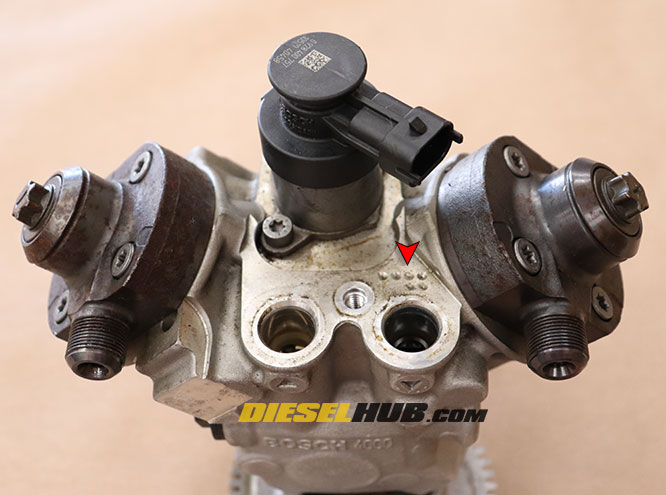
Old style CP4 injection pump with asymmetrical camshaft lobe profile.
Note the series of dimples near the fuel inlet port (red arrow).
This injection pump was removed from a 2016 Ford Super Duty with the 6.7L Power Stroke diesel.

New style CP4 injection pump with symmetrical camshaft lobe profile.
Note the single large dimple near the the fuel inlet port (red arrow).
This injection pump is on a 2020 Ram 2500 with the 6.7L Cummins turbodiesel.
Ram Cummins CP4 Recall & Dealer CP3 Conversion
FCA voluntarily issued a recall for an estimated 222,410 Ram 2500, 3500, 4500, and 5500 trucks equipped with the Bosch CP4 injection pump over concerns that a high pressure fuel pump failure could result in a serious accident in the event a vehicle lost power or stalled while in motion. The recall was filed with the National Highway Traffic Safety Administration (NHTSA recall number 21V-880) December 16th, 2021. Affected trucks include:
• Ram 2500 pickup trucks built between 10/11/18 and 11/13/2020
• Ram 3500 pickup trucks built between 10/18/18 and 11/13/2020
• Ram 3500, 4500, & 5500 chassis cab trucks built between 11/29/18 and 11/13/2020
The recall, available free of charge through dealerships to owners of affected vehicles, directs dealers to install a Bosch CP3 injection pump in place of the troubled CP4, inspect the fuel system for contamination, and update the PCM with a new, CP3 friendly calibration. Notices have been sent to owners of affected vehicles and additional information is available from the NHTSA website. FCA remains the first and only manufacturer to acknowledge the shortcomings of the Bosch CP4 injection pump through a vehicle recall program.
Key Takeaways on the Bosch CP4 Injection Pump
The majority of the information circulating about the Bosch CP4 is negative and relates to personal experiences and gripes with injection pump failures, giving the unit an overwhelmingly negative outlook. While we agree that the Bosch CP4 has a high failure rate, no one knows for certain exactly what that failure rate is; after all, we'll never hear from most truck owners that have not had problems. What we do know is that the CP4 has a tendency to fail somewhat catastrophically, often wiping out the entire fuel system. Most CP4 failures happen abruptly with little to no warning signs because the evidence, that is the metal debris floating through the fuel system, can go undetected for extended periods of time. Know the warning signs, service your fuel system regularly, and consider using a supplement diesel fuel additive to prolong the life of your Bosch CP4 injection pump.
Summary & Key Points
• Although actual figures are unavailable, the Bosch CP4 injection pump has a historically high failure rate that is often linked to its aggressive camshaft lobe profile and inadequate lubrication source
• FCA recalled all 2019 to 2020 model year vehicles equipped with a 6.7L Cummins turbodiesel employing the Bosch CP4 pump; they remain the first and only automaker to acknowledge the pump's shortcomings
• Religiously using a diesel fuel additive to increase the fuel's lubricity may extend the life of a Bosch CP4 pump
